Sanjay Kariyappa
NVIDIA Nemotron 3: Efficient and Open Intelligence
Dec 24, 2025Abstract:We introduce the Nemotron 3 family of models - Nano, Super, and Ultra. These models deliver strong agentic, reasoning, and conversational capabilities. The Nemotron 3 family uses a Mixture-of-Experts hybrid Mamba-Transformer architecture to provide best-in-class throughput and context lengths of up to 1M tokens. Super and Ultra models are trained with NVFP4 and incorporate LatentMoE, a novel approach that improves model quality. The two larger models also include MTP layers for faster text generation. All Nemotron 3 models are post-trained using multi-environment reinforcement learning enabling reasoning, multi-step tool use, and support granular reasoning budget control. Nano, the smallest model, outperforms comparable models in accuracy while remaining extremely cost-efficient for inference. Super is optimized for collaborative agents and high-volume workloads such as IT ticket automation. Ultra, the largest model, provides state-of-the-art accuracy and reasoning performance. Nano is released together with its technical report and this white paper, while Super and Ultra will follow in the coming months. We will openly release the model weights, pre- and post-training software, recipes, and all data for which we hold redistribution rights.
Nemotron 3 Nano: Open, Efficient Mixture-of-Experts Hybrid Mamba-Transformer Model for Agentic Reasoning
Dec 23, 2025Abstract:We present Nemotron 3 Nano 30B-A3B, a Mixture-of-Experts hybrid Mamba-Transformer language model. Nemotron 3 Nano was pretrained on 25 trillion text tokens, including more than 3 trillion new unique tokens over Nemotron 2, followed by supervised fine tuning and large-scale RL on diverse environments. Nemotron 3 Nano achieves better accuracy than our previous generation Nemotron 2 Nano while activating less than half of the parameters per forward pass. It achieves up to 3.3x higher inference throughput than similarly-sized open models like GPT-OSS-20B and Qwen3-30B-A3B-Thinking-2507, while also being more accurate on popular benchmarks. Nemotron 3 Nano demonstrates enhanced agentic, reasoning, and chat abilities and supports context lengths up to 1M tokens. We release both our pretrained Nemotron 3 Nano 30B-A3B Base and post-trained Nemotron 3 Nano 30B-A3B checkpoints on Hugging Face.
Stronger Enforcement of Instruction Hierarchy via Augmented Intermediate Representations
May 25, 2025
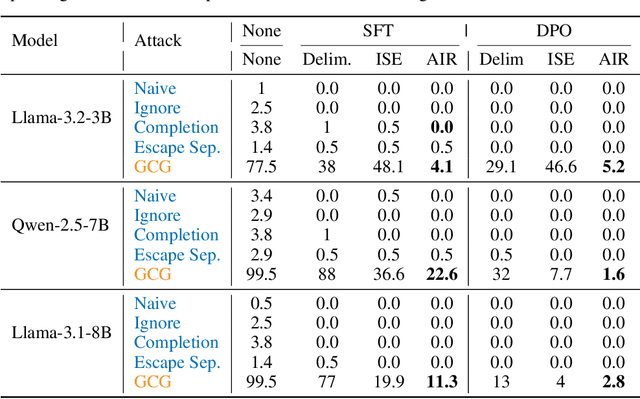
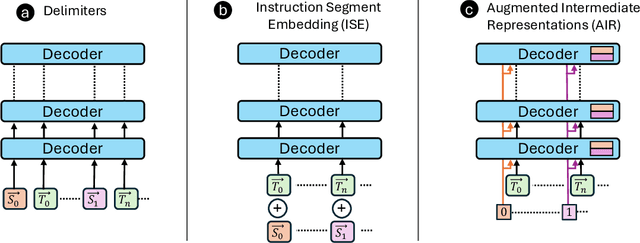
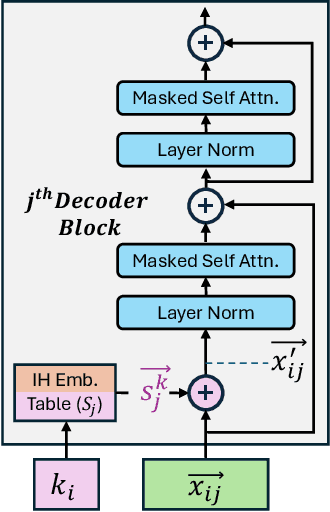
Abstract:Prompt injection attacks are a critical security vulnerability in large language models (LLMs), allowing attackers to hijack model behavior by injecting malicious instructions within the input context. Recent defense mechanisms have leveraged an Instruction Hierarchy (IH) Signal, often implemented through special delimiter tokens or additive embeddings to denote the privilege level of input tokens. However, these prior works typically inject the IH signal exclusively at the initial input layer, which we hypothesize limits its ability to effectively distinguish the privilege levels of tokens as it propagates through the different layers of the model. To overcome this limitation, we introduce a novel approach that injects the IH signal into the intermediate token representations within the network. Our method augments these representations with layer-specific trainable embeddings that encode the privilege information. Our evaluations across multiple models and training methods reveal that our proposal yields between $1.6\times$ and $9.2\times$ reduction in attack success rate on gradient-based prompt injection attacks compared to state-of-the-art methods, without significantly degrading the model's utility.
Interpretable LLM-based Table Question Answering
Dec 16, 2024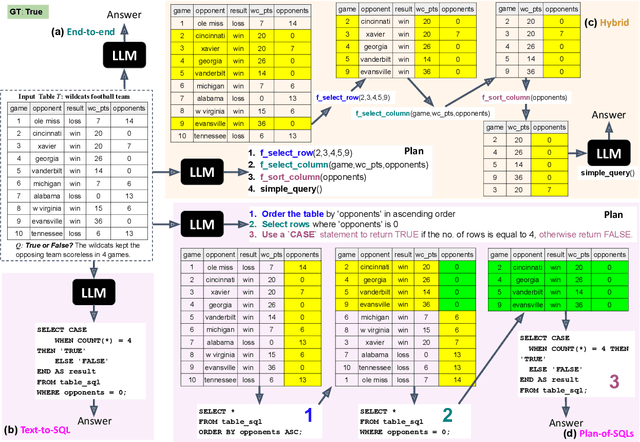

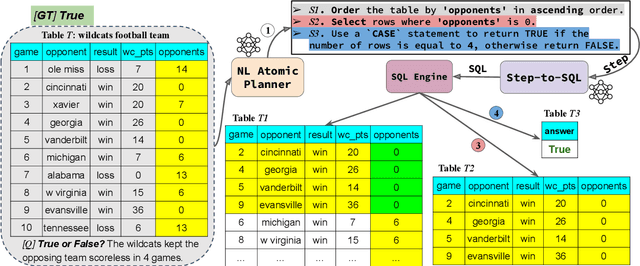

Abstract:Interpretability for Table Question Answering (Table QA) is critical, particularly in high-stakes industries like finance or healthcare. Although recent approaches using Large Language Models (LLMs) have significantly improved Table QA performance, their explanations for how the answers are generated are ambiguous. To fill this gap, we introduce Plan-of-SQLs ( or POS), an interpretable, effective, and efficient approach to Table QA that answers an input query solely with SQL executions. Through qualitative and quantitative evaluations with human and LLM judges, we show that POS is most preferred among explanation methods, helps human users understand model decision boundaries, and facilitates model success and error identification. Furthermore, when evaluated in standard benchmarks (TabFact, WikiTQ, and FetaQA), POS achieves competitive or superior accuracy compared to existing methods, while maintaining greater efficiency by requiring significantly fewer LLM calls and database queries.
Progressive Inference: Explaining Decoder-Only Sequence Classification Models Using Intermediate Predictions
Jun 03, 2024



Abstract:This paper proposes Progressive Inference - a framework to compute input attributions to explain the predictions of decoder-only sequence classification models. Our work is based on the insight that the classification head of a decoder-only Transformer model can be used to make intermediate predictions by evaluating them at different points in the input sequence. Due to the causal attention mechanism, these intermediate predictions only depend on the tokens seen before the inference point, allowing us to obtain the model's prediction on a masked input sub-sequence, with negligible computational overheads. We develop two methods to provide sub-sequence level attributions using this insight. First, we propose Single Pass-Progressive Inference (SP-PI), which computes attributions by taking the difference between consecutive intermediate predictions. Second, we exploit a connection with Kernel SHAP to develop Multi Pass-Progressive Inference (MP-PI). MP-PI uses intermediate predictions from multiple masked versions of the input to compute higher quality attributions. Our studies on a diverse set of models trained on text classification tasks show that SP-PI and MP-PI provide significantly better attributions compared to prior work.
Privacy-Preserving Algorithmic Recourse
Nov 23, 2023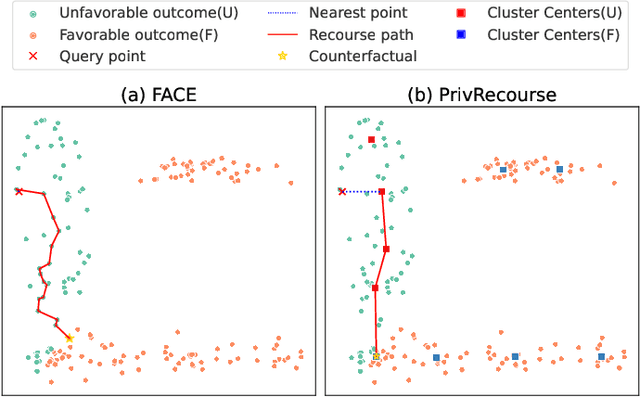

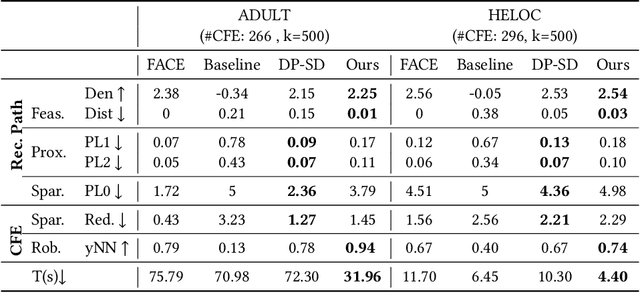

Abstract:When individuals are subject to adverse outcomes from machine learning models, providing a recourse path to help achieve a positive outcome is desirable. Recent work has shown that counterfactual explanations - which can be used as a means of single-step recourse - are vulnerable to privacy issues, putting an individuals' privacy at risk. Providing a sequential multi-step path for recourse can amplify this risk. Furthermore, simply adding noise to recourse paths found from existing methods can impact the realism and actionability of the path for an end-user. In this work, we address privacy issues when generating realistic recourse paths based on instance-based counterfactual explanations, and provide PrivRecourse: an end-to-end privacy preserving pipeline that can provide realistic recourse paths. PrivRecourse uses differentially private (DP) clustering to represent non-overlapping subsets of the private dataset. These DP cluster centers are then used to generate recourse paths by forming a graph with cluster centers as the nodes, so that we can generate realistic - feasible and actionable - recourse paths. We empirically evaluate our approach on finance datasets and compare it to simply adding noise to data instances, and to using DP synthetic data, to generate the graph. We observe that PrivRecourse can provide paths that are private and realistic.
SHAP@k:Efficient and Probably Approximately Correct (PAC) Identification of Top-k Features
Jul 10, 2023


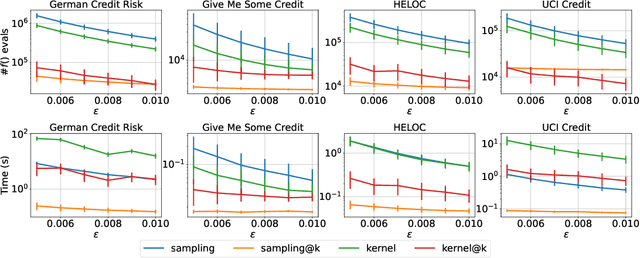
Abstract:The SHAP framework provides a principled method to explain the predictions of a model by computing feature importance. Motivated by applications in finance, we introduce the Top-k Identification Problem (TkIP), where the objective is to identify the k features with the highest SHAP values. While any method to compute SHAP values with uncertainty estimates (such as KernelSHAP and SamplingSHAP) can be trivially adapted to solve TkIP, doing so is highly sample inefficient. The goal of our work is to improve the sample efficiency of existing methods in the context of solving TkIP. Our key insight is that TkIP can be framed as an Explore-m problem--a well-studied problem related to multi-armed bandits (MAB). This connection enables us to improve sample efficiency by leveraging two techniques from the MAB literature: (1) a better stopping-condition (to stop sampling) that identifies when PAC (Probably Approximately Correct) guarantees have been met and (2) a greedy sampling scheme that judiciously allocates samples between different features. By adopting these methods we develop KernelSHAP@k and SamplingSHAP@k to efficiently solve TkIP, offering an average improvement of $5\times$ in sample-efficiency and runtime across most common credit related datasets.
Information Flow Control in Machine Learning through Modular Model Architecture
Jun 05, 2023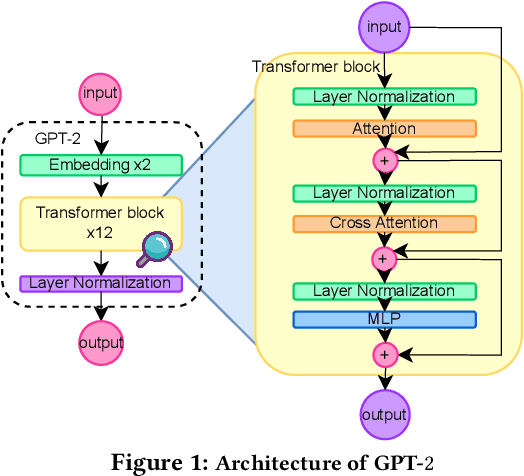
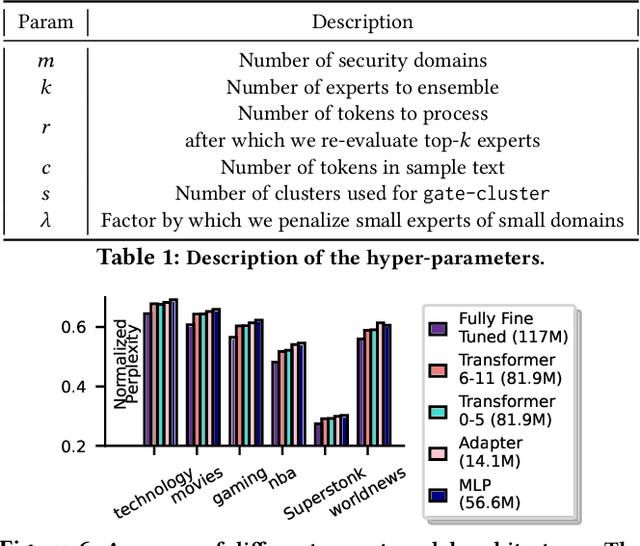
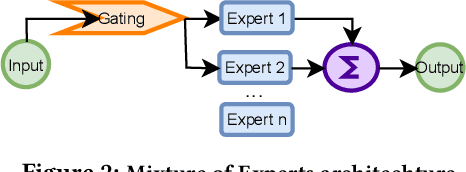

Abstract:In today's machine learning (ML) models, any part of the training data can affect its output. This lack of control for information flow from training data to model output is a major obstacle in training models on sensitive data when access control only allows individual users to access a subset of data. To enable secure machine learning for access controlled data, we propose the notion of information flow control for machine learning, and develop a secure Transformer-based language model based on the Mixture-of-Experts (MoE) architecture. The secure MoE architecture controls information flow by limiting the influence of training data from each security domain to a single expert module, and only enabling a subset of experts at inference time based on an access control policy. The evaluation using a large corpus of text data shows that the proposed MoE architecture has minimal (1.9%) performance overhead and can significantly improve model accuracy (up to 37%) by enabling training on access-controlled data.
Bounding the Invertibility of Privacy-preserving Instance Encoding using Fisher Information
May 06, 2023Abstract:Privacy-preserving instance encoding aims to encode raw data as feature vectors without revealing their privacy-sensitive information. When designed properly, these encodings can be used for downstream ML applications such as training and inference with limited privacy risk. However, the vast majority of existing instance encoding schemes are based on heuristics and their privacy-preserving properties are only validated empirically against a limited set of attacks. In this paper, we propose a theoretically-principled measure for the privacy of instance encoding based on Fisher information. We show that our privacy measure is intuitive, easily applicable, and can be used to bound the invertibility of encodings both theoretically and empirically.
Measuring and Controlling Split Layer Privacy Leakage Using Fisher Information
Sep 21, 2022
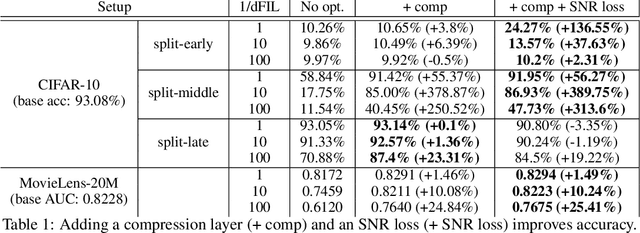


Abstract:Split learning and inference propose to run training/inference of a large model that is split across client devices and the cloud. However, such a model splitting imposes privacy concerns, because the activation flowing through the split layer may leak information about the clients' private input data. There is currently no good way to quantify how much private information is being leaked through the split layer, nor a good way to improve privacy up to the desired level. In this work, we propose to use Fisher information as a privacy metric to measure and control the information leakage. We show that Fisher information can provide an intuitive understanding of how much private information is leaking through the split layer, in the form of an error bound for an unbiased reconstruction attacker. We then propose a privacy-enhancing technique, ReFIL, that can enforce a user-desired level of Fisher information leakage at the split layer to achieve high privacy, while maintaining reasonable utility.
 Add to Chrome
Add to Chrome Add to Firefox
Add to Firefox Add to Edge
Add to Edge